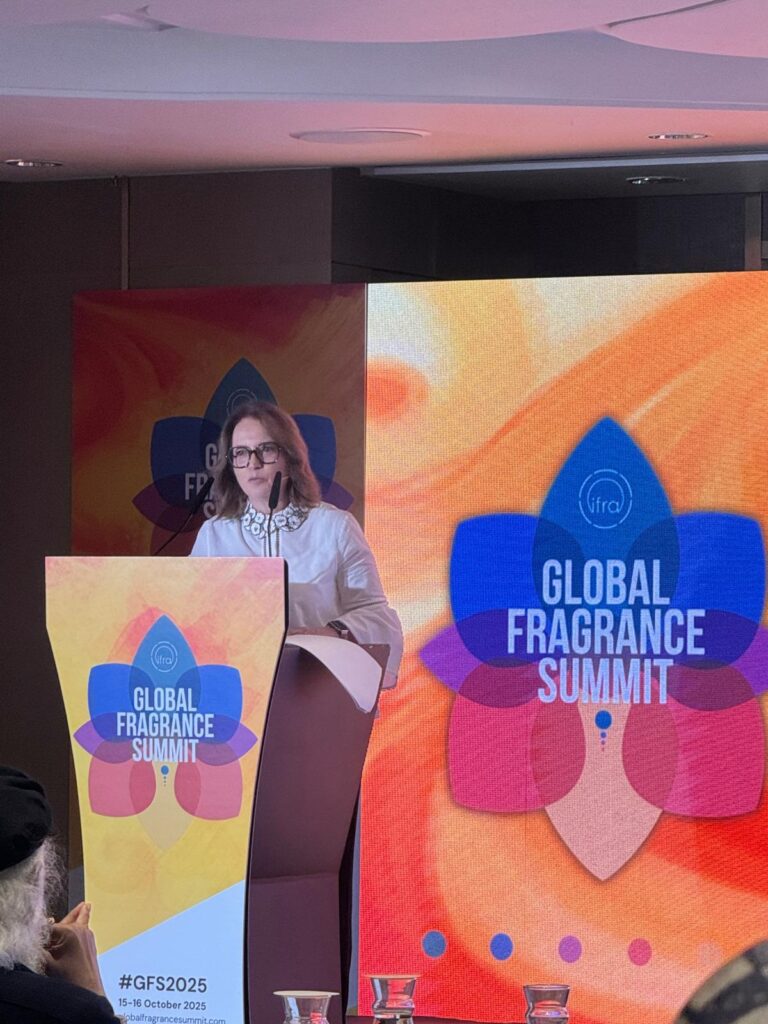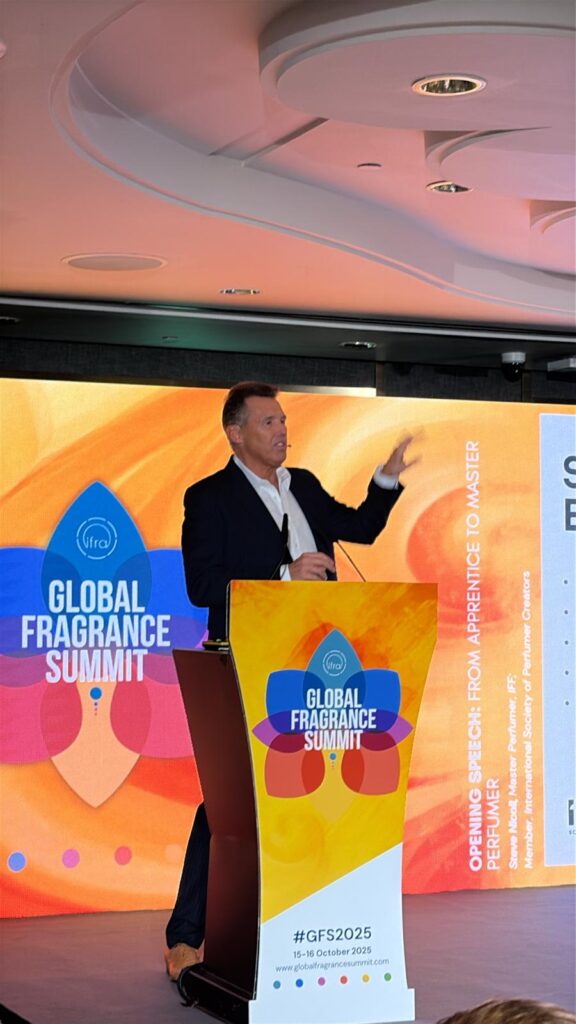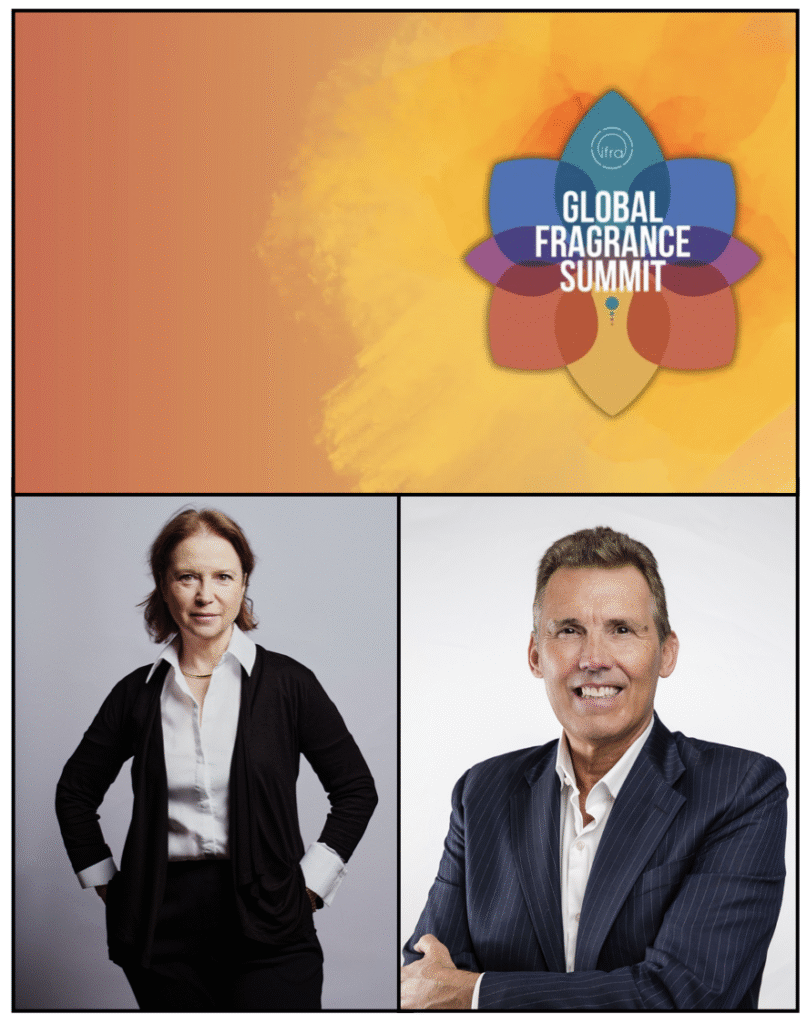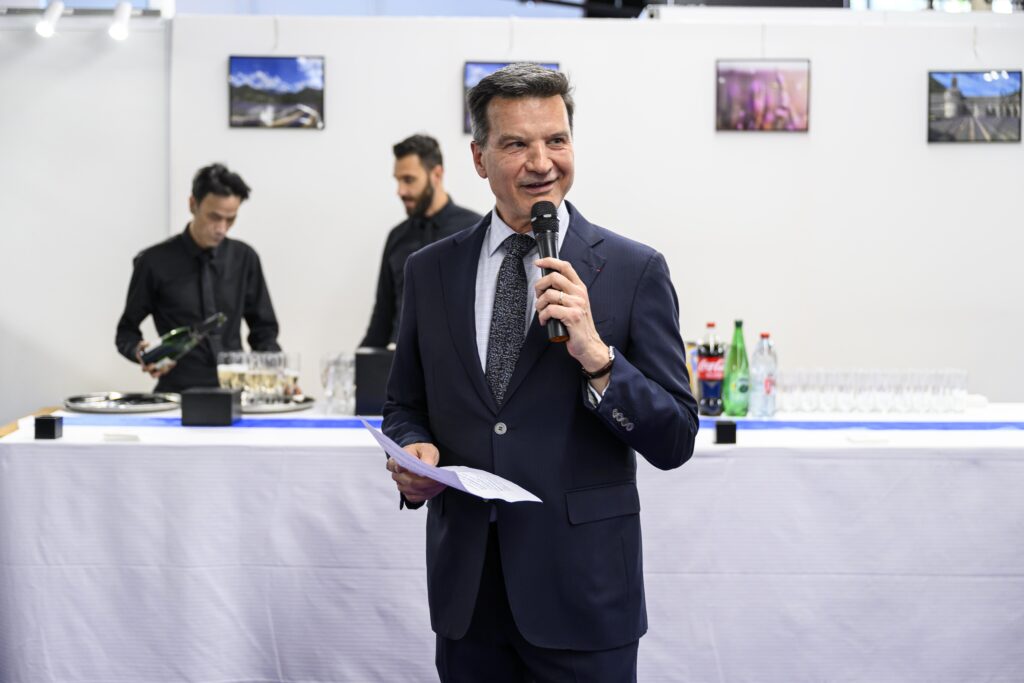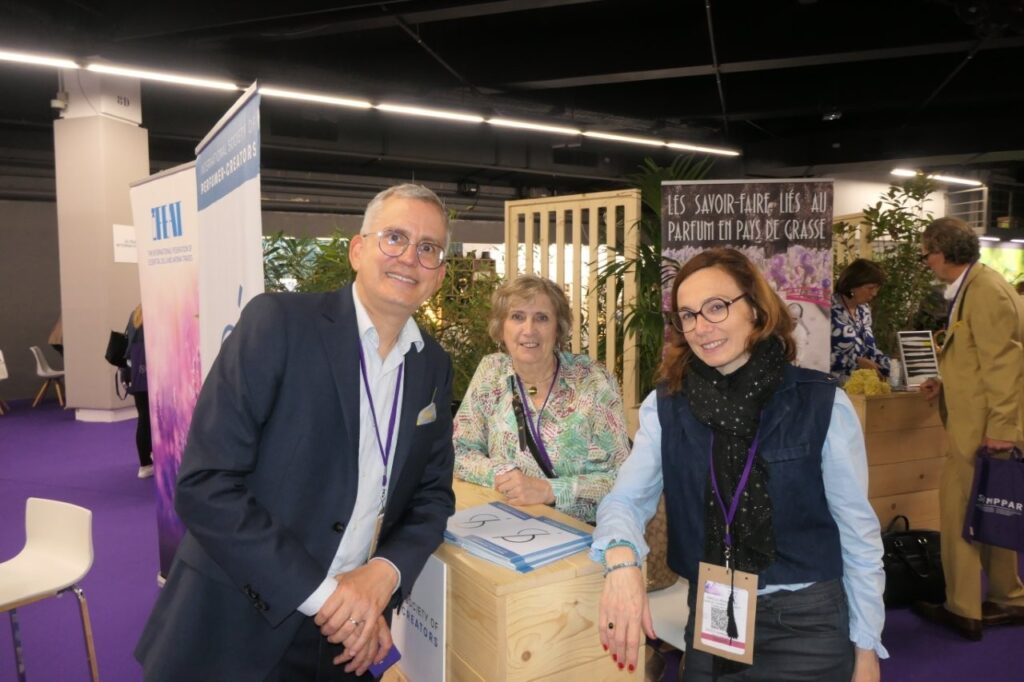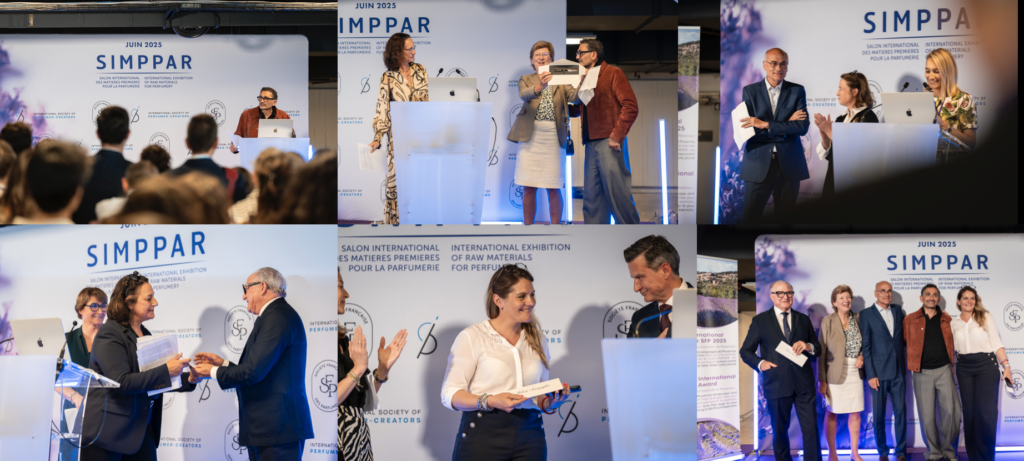Calice Becker, the ISPC vice-president, as well as part of the ISPC/IFRA Committee, is sharing the content of her presentation from the IFRA Global Fragrance Summit 2025 held in Singapore with the entire ISPC perfumer community.
Calice’s session focused on “Perfume, Regulation, and the Art of Balance”.
“Nine hundred and twenty percent.
You may wonder what that number represents. It’s the astonishing growth of the global fragrance market over the past forty years — from $4.9 billion in 1985 to more than $50 billion in 2025.
I’ve lived through that evolution. For four decades I’ve worked in this extraordinary industry. Today I lead and teach at the Givaudan Perfumery School, after years serving as President and Co‑President of the ISPC. I have seen perfumery evolve from a symbol of luxury into an essential part of everyday living — shaping hygiene, beauty, and home care. Once a gift reserved for special occasions, fragrance has become the main bying driver behind any household products.
And now, haute perfumery — long thought an endangered art — is back. Product launches multiply every month. Even Esxence, the Milan fair dedicated to artistic perfumery, has to expand its space year after year to keep up. Compared with other sectors, our growth has been nothing short of explosive: the automotive industry, for instance, grew only around 50% in the same period. And, as I sometimes joke to my students, a great perfume lasts far longer than shoulder pads ever did.
With all this dynamism, regulation inevitably followed, bringing both protection and complexity. Before going further, a short disclaimer: what I share here is my personal view — not the official voice of Givaudan or the ISPC — but the reflection of a lifetime immersed in this craft.
When I first entered the perfumery school in the mid‑1980s, IFRA — the International Fragrance Association — had been around for about a decade. Musk Ambrette was already restricted, Musk Ketone under scrutiny for its xylene content. IFRA itself had been born in 1973. I still remember the first guidelines on Musk Ketone, and the uproar after Musk Xylene was banned. Many perfumers felt creativity had reached its end.
We’ve come a long way since then.
There was a time when photosensitizing ingredients — the kind that make skin more sensitive to light — were used deliberately to tan faster. Furocoumarins, found in bergapten from bergamot oil, were among them. Yes, the same bergamot we all love in perfumery. But back in the 1970s, safety wasn’t the concern it is today. A tan meant wealth and success. Sunscreens were made not to block sunlight but to intensify it. Ads for Bergasol (Parasol ou Bergasol?) showed one woman pale, another beautifully bronzed, promoting the promise of a faster tan.
Regulation, at first, was a necessary corrective. It made products safer for everyone.
Take cinnamon oil. Historically applied to the scalp to stimulate blood flow, it’s a natural irritant. In perfumery, however, we use it at infinitesimally low doses — precise, controlled, and perfectly safe. The guiding principle remains the same: dose and exposure determine risk. At low levels, these ingredients add warmth, character, and depth without any irritation at those levels.
Yet since those days, the pendulum has swung — from no regulation to what at times feels like over‑regulation. Consider octocrylene, a UV filter now under scrutiny by the European Chemicals Agency. The studies driving these restrictions were conducted at concentrations thousands of times higher than any real environmental exposure. That isn’t balanced science; it’s fear disguised as data. It’s a perfect example of good intentions drifting toward excess.
And herein lies the paradox. Our quantities are tiny — the actual exposure to perfume ingredients is minuscule — yet perfumers are judged by the same chemical standards applied to heavy industry. It’s neither fair nor logical. Dose and exposure remain the cornerstones of safety.
That’s why IFRA’s role is so crucial. It represents the equilibrium between creativity and caution, where science meets artistry. Thanks to their work, perfumers can continue to explore the universe of scent freely and safely.
We’ve grown far from the days when bergamot oil darkened skin under the sun, when every car had an ashtray and no one wore seatbelts. The past may look reckless through today’s lens, but context matters. In trying to protect people, we must ensure we don’t smother what makes life beautiful. Safety, beauty, and well‑being — they belong together.
The rules that govern perfumery today were designed largely for the broader chemical industry. Ours is a smaller world — yet one carrying immense cultural weight. Since 1973 we’ve relied on IFRA to navigate an increasingly intricate web of authorities and standards. Unfortunately, that web is not harmonized. Different regulatory bodies operate independently, often adding layers of complication. Sometimes I wonder: wouldn’t it be simpler to remain under IFRA’s unified guidance?
When I reflect on our path, I see two themes: one rooted in heritage, the other in the future — both calling for wise stewardship in the present.
The Past
Think of Guerlain’s legendary perfumes. Generations in Europe have known their scent. Reformulating them, however, can be heartbreaking. Mitsouko once contained ingredients now restricted — musk ketone, methyl eugenol from pimento and rose, atranol in oakmoss. Changing them is like cutting away part of collective memory.
Perfumers work tirelessly to find substitutes, even as new constraints multiply. Most of these restricted molecules are used in micro amounts and pose little to no risk, but regulations treat them as villains. This is why collaboration between IFRA and ISPC remains vital — to protect the perfumer’s palette.
Interestingly, most consumers keep their fragrances for years, even decades. They don’t discard bottles annually, as recommended. So why not treat them like vintage wines? Label the year of creation, indicating which regulations applied then. For collectors, that could add historical depth.
Here’s a practical tip, too: anticipate. If your favourite perfume might be reformulated, buy a few bottles in advance. If the year isn’t noted, write it yourself. Store them in a cool, dark place — even in the fridge — to preserve their character. Without heliotropin, for instance, L’Heure Bleue may lose some of its signature smoothness by 2027.
Ultimately, we must protect our olfactory heritage. The Osmothèque in Versailles does this magnificently, preserving formulas no longer permitted for wear. They serve as our cultural memory — not to be worn, but to be remembered.
The Future
Still, perfumers are not just curators. We are creators. Constraint, paradoxically, can be the mother of invention.
The writer Georges Perec proved it with literature. La Disparition contained not a single letter “E.” . It is a quite challenging to read yet profoundly creative. I see the same in my students: when given total freedom, they often freeze; when offered clear limitations, they flourish. Constraint provides structure, and structure fuels creativity. But Les Revenentes , another novel pushing the constraints to the extreme using only the vowel E … it is barely readable. That what over regulation can do to fragrances, defeat the purpose.
On a positive note: restrictions also lead to breakthroughs. Ingredient bans and reformulations spur chemists to explore new paths. Calone was discovered accidentally at Pfizer while developing additives — and it birthed a whole new olfactory family: marine freshness. Without that, we might never have had Aqua di Gio , L’Eau d’Issey Miyake , or Kenzo pour Homme .
Sometimes, molecules classified as CMR (carcinogenic, mutagenic, or reprotoxic) are redesigned entirely. Today chemists identify which parts of a structure cause concern, then rebuild the molecule safely. This is how Nympheal — a replacement for Lilial — came to life under Thierry Audibert’s direction. By understanding toxicology deeply, we can preserve the beauty of scent while eliminating risk.
Constraints also spark innovation in our tools. Consider the brick: its shape defined architectural geometry for centuries. Then molded concrete — and later 3D printing — liberated form from the straight line. The same is happening in perfumery, where microencapsulation and other technologies reinvent how scent is delivered.
Technology magnifies our intuition rather than replacing it. With olfactometric mapping tools such as Givaudan’s Carto, we can harmonize ingredients like never before. The algorithm proposes proportions previously untried, and the result is astonishing.
And beyond tools, there is the art of combination itself.
In 1961, Raymond Queneau published A Hundred Thousand Billion Poems . Ten sonnets, each line printed separately so readers could mix and match — generating 10¹⁴ possible poems. An enormous number, yet minuscule compared to science’s vastness: the observable universe holds roughly 10⁸⁰ atoms. And still, those numbers pale next to perfumery’s combinatorial potential.
A fragrance formula may have 10 to 200 ingredients in proportions lets say from 0.1% to 50%. Theoretically, it represents 10³⁰⁰ possible combinations — a creative infinity. Even after excluding absurd mixtures, the possibilities defy imagination. And yet, we classify perfumes into merely six olfactive families, perhaps seven now with gourmands inspired by Angel . Those families barely scratch the surface. Entire new categories await discovery.
So to those who believed perfumery’s creative era ended when musk ketone was banned, I would say: on the contrary. The true universe of scent still lies ahead.
Reflection
After forty years in this craft, I can affirm that today’s perfumery as the world we live in is safer than ever — but perhaps also more anxious. We reformulate endlessly, seeking compliance with each wave of new regulation. And it’s fair to ask: does every reformulation truly serve safety, or does it sometimes merely serve precaution without proportion?
Wouldn’t labelling — acknowledging a fragrance’s vintage, its regulatory context — be a wiser way to preserve our olfactory heritage? Some masterpieces, the “sacred monsters” that defined entire generations, can no longer exist in their original form. The Osmothèque keeps their spirit alive, ensuring that future generations can still experience their beauty.
When I look at the world today — sanitized, screen-lit, perhaps a little sadder — I am reminded why perfume matters. Like laughter or love, it is not indispensable, but it is essential. It gives texture to memory, humanity to science, and a whisper of joy in a cautious world.
Let’s make sure that regulation — however well‑intentioned — never extinguishes that vital spark.”
